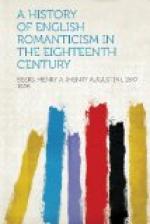At last they bethink themselves of a certain lawyer’s clerk, who had first imported these literary disputes into the village, in 1824. To him, they expose their difficulties and ask for an answer to the question, What is romanticism? After a long conversation, they receive this final definition. “Romanticism, my dear sir! No, of a surety, it is neither the disregard of the unities, nor the alliance of the comic and tragic, nor anything in the world expressible by words. In vain you grasp the butterfly’s wing; the dust which gives it its color is left upon your fingers. Romanticism is the star that weeps, it is the wind that wails, it is the night that shudders, the bird that flies and the flower that breathes perfume: it is the sudden gush, the ecstasy grown faint, the cistern beneath the palms, rosy hope with her thousand loves, the angel and the pearl, the white robe of the willows. It is the infinite and the starry,” etc., etc.
Then M. Ducoudray, a magistrate of the department, gives his theory of romanticism, which he considers to be an effect of the religious and political reaction under the restored Bourbon monarchy of Louis XVIII, and Charles X. “The mania for ballads, arriving from Germany, met the legitimist poetry one fine day at Ladvocat’s bookshop; and the two of them, pickax in hand, went at nightfall to a churchyard, to dig up the Middle Ages.” The taste for medievalism, M. Ducoudray adds, has survived the revolution of 1830, and romanticism has even entered into the service of liberty and progress, where it is a manifest anachronism, “employing the style of Ronsard to celebrate railroads, and imitating Dante when it chants the praises of Washington and Lafayette.” Dupuis was tempted to embrace M. Ducoudray’s explanation, but Cotonet was not satisfied. He shut himself in, for four months, at the end of which he announced his discovery that the true and only difference between the classic and the romantic is that the latter uses a good many adjectives. He illustrates his principle by giving passages from “Paul and Virginia” and the “Portuguese Letters,” written in the romantic style.
Thus Musset pricks a critical bubble with the point of his satire; and yet the bubble declines to vanish. There must really be some more substantial difference than this between classic and romantic, for the terms persist and are found useful. It may be true that the romantic temper, being subjective and excited, tends to an excess in adjectives; the adjective being that part of speech which attributes qualities, and is therefore most freely used by emotional persons. Still it would be possible to cut out all the adjectives, not strictly necessary, from one of Tieck’s Maerchen without in the slightest degree disturbing its romantic character.




